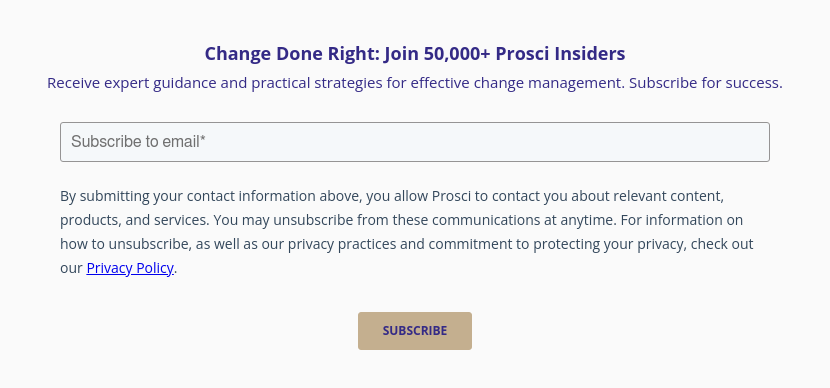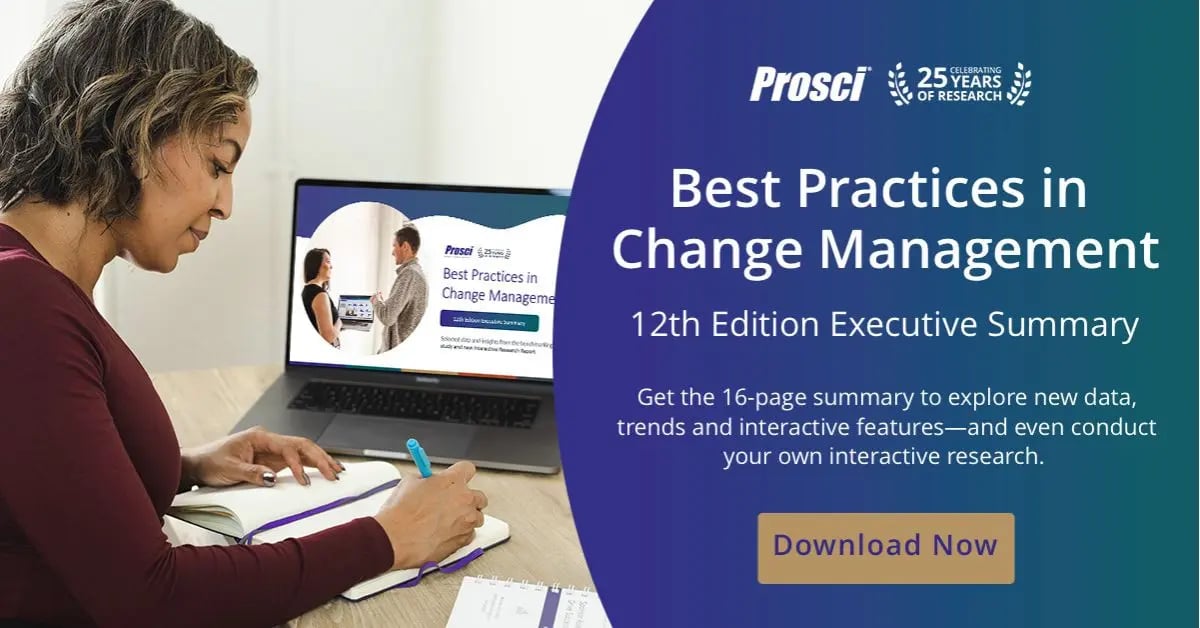

Collectively and consistently, participant responses point to seven straightforward factors that impact the results of a change initiative. These are the best practices in change management, as reported to Prosci by thousands of change leaders around the world.
Starting with the 12 th Edition, Prosci’s Best Practices in Change Management research report offers you deeper insights through interactive features. You can customize data by industry, organization size and project type to support your specific changes. You can also read participant comments, cross-reference data, and free-explore data in a variety of areas. Our aim is to empower you to uncover the change management insights that matter most to you and your organization.
The discussion that follows here is a small sample of our latest findings.
Research participants who identified these contributors to successful change are experienced practitioners, project leaders, executives and consultants. Forty percent of participants in 12th edition of the Best Practices in Change Management study have more than nine years of experience in change management, while 9% have been applying change management less than a year.
Having a positive leader who actively guides the organization through change and participates visibly throughout the lifecycle of change has endured as the top contributor to success since 1998. The importance of sponsorship is cited more frequently than any other contributor, and participants consistently use the key words “active and visible” to describe it. Active and visible sponsorship means the sponsor:
Forty-eight percent of participants in the research say they have an effective or very effective sponsor. Because sponsor effectiveness correlates with the likelihood of meeting project objectives, their organizations usually enjoy high rates of change success.
In fact, our research shows that projects with extremely ineffective sponsors were only 27% likely to meet their objectives as compared to 79% with extremely effective sponsors—a nearly threefold increase in the likelihood of success.

An intentional and defined approach to managing change provides the structure necessary to stay on track. It designates adequate time for meaningful activities and allows space to identify and address gaps throughout the project lifecycle. Using a formal approach also makes processes repeatable for consistent application of change management on more initiatives across an organization. Key words that emerged when participants described this best practice include:
How organizations use a structured approach varies in the research. Sixty-nine percent use a change management methodology for general guidance, as a checklist for activities, to monitor progress, or a combination of these.
Again, the research reveals just how much applying a structured approach contributes to success. Of the participants who applied a particular methodology, 59% achieved good or excellent levels of change management effectiveness, while only 26% achieved the same levels of effectiveness without a structured approach.


The goal of these efforts is to help employees demonstrate willingness to participate in the change and collaborate with the people leading it.
Engaging in reinforcement and sustainment activities with front-line employees is a critical step in the change management process. But organizations that are saturated with change often neglect these activities and mistakenly consider a change complete at go-live.
Inadequately addressing reinforcement and sustainment activities has a negative impact on the outcome of the change. As the data shows, participants who allocated resources for reinforcement activities, including engaging with impacted employees, were more likely to achieve project objectives than those who did not.

Change management practitioners often struggle against the misconception that change management is "just communications." Although change management is much more than that, effective communications are critical to leading change successfully. Beyond frequency, participants cited these factors as important to success:
Notably, 58% of employees prefer to receive communications about the personal impacts of change directly from their supervisors. Most want to hear about the business reasons for the change from the CEO. However, a significant number of participants in the 12th edition study also cited other executives, senior managers, and department heads as preferred senders of organizational messages.
Additionally, participants identified important topics to communicate, such as why the change is happening, expectations, long-term plan perspectives, how the change will impact employees, and essential business drivers.

Prosci's AI tool, Kaiya, can help you craft consistent and transparent messages, as well as communication plans that resonate with your team and stakeholders.
Prosci’s research underscores the best practice of integrating change management work with project management activities. These complementary disciplines naturally cross paths throughout the life of an initiative, enabling a unified value proposition and more successful changes.
In our research, nearly three-quarters of all respondents integrate project management work and change management work to some degree. Integration dimensions include people, processes, methodology, results and outcomes, tools, and other areas, with people being the most common dimension at 86%.
Specific examples of integration include:
More and more organizations realize the value of integrating project management and change management. And research participants who integrated these two disciplines were far more likely to meet or exceed project objectives than those who did not integrate.

Your project needs dedicated resources and funding to get change management work done. Dedicated change management resources and funding means having access to:
As one research participant said, “If it isn’t someone’s job, then it’s no one’s job.” To realize the benefits of change management, someone must be responsible for it and have access to an appropriate amount of funding.
The data reveals a positive and meaningful correlation between having a dedicated resource (person) and overall change management effectiveness. Participants with dedicated resources were significantly more likely to achieve good or excellent change management effectiveness than those without a dedicated resource.

People managers can become a change practitioner’s greatest ally in times of change because they are closest to employees impacted by change. Research participants explain this top contributor as:
The research identified mid-level managers as the group most resistant to change, with 43% of participants identifying them as such. Past research shows that a majority of this resistance can be mitigated by thoroughly addressing this group in the change plans.

Prosci has produced 12 Best Practices in Change Management reports over the last 25 years, compiling data from more than 10,800 responses provided by change management professionals in 38 industries in 101 countries. You can apply the best practices and interactive data in Research Hub to:
As change management gains momentum as a crucial discipline, organizations worldwide are embracing people-first approaches that facilitate successful transformation. By incorporating these best practices, you and your organization can continue to evolve and learn alongside the discipline, achieving even greater success from change.


Tim Creasey is Prosci’s Chief Innovation Officer and a globally recognized leader in Change Management. Their work forms the basis of the world's largest body of knowledge on managing the people side of change to deliver organizational results.
See all posts from Tim Creasey